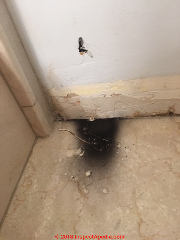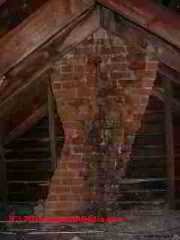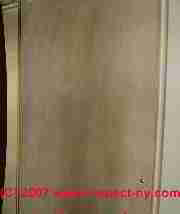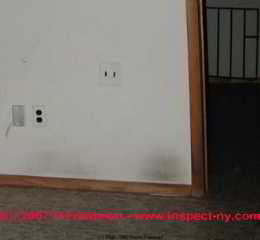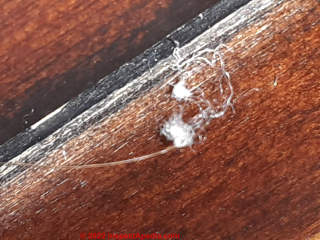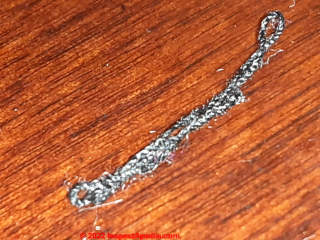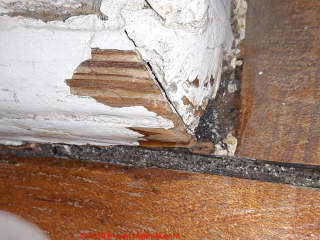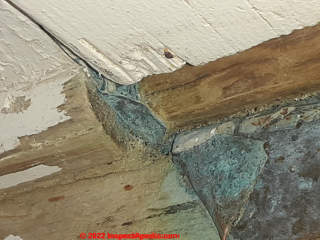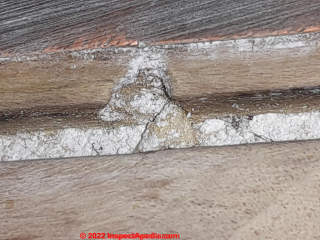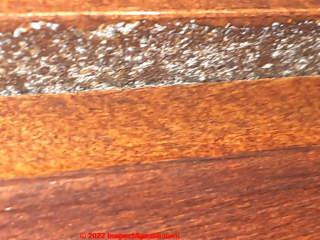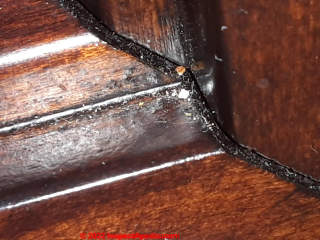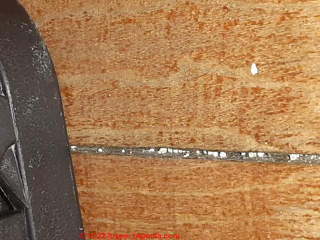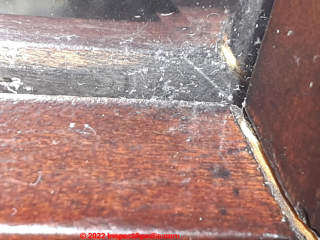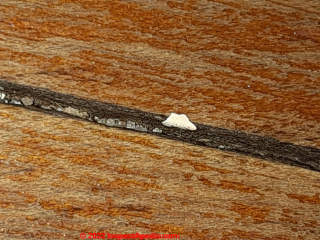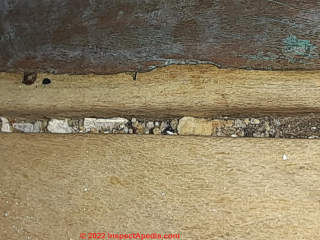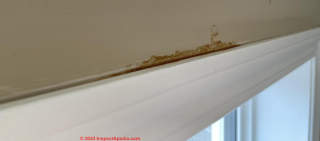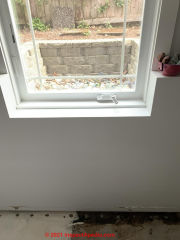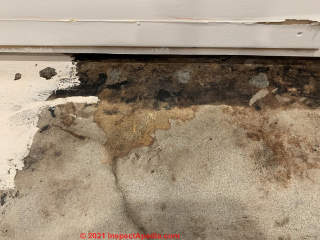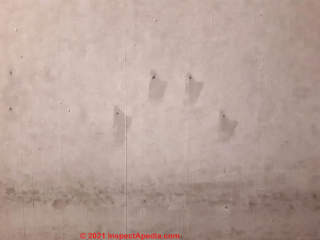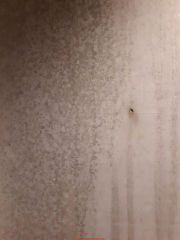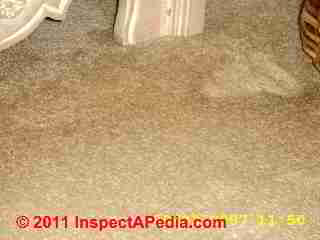 Stains on Building Interiors
Diagnostic & Photo Guide to Stains on Carpets, Ceilings, Floors, Walls
Stains on Building Interiors
Diagnostic & Photo Guide to Stains on Carpets, Ceilings, Floors, Walls
- POST a QUESTION or COMMENT about diagnosing the causes of stains found on indoor surfaces
How to diagnose Indoor stains in buildings:
This article describes & diagnoses the cause of interior stains on buildings: stains of all colors, black or dark, grown, green, red, yellow, tank, or gray can appear on interior wall, ceiling, flooring or carpeting and may be due to a variety 9of sources, some of which are dangerous, others just "cosmetic".
Here we explain how to recognize their probable cause and source, including soot stains, house dust stains, pet or animal stains, and thermal tracking or thermal bridging stains associated with building air leaks, and building insulation defects.
InspectAPedia tolerates no conflicts of interest. We have no relationship with advertisers, products, or services discussed at this website.
Guide to Types of Stains on Building Interior Surfaces:
In the following guide we list types of stains found on building interiors, organized by by stain color & appearance, by building location or material, and by stain cause.
Some of these types of roof stains or discoloration are only cosmetic in nature, while others may indicate growths that are likely to reduce the roof covering life.
Black or dark stains on building interiors: such as on carpets, ceilings, walls, floors, drywall, or trim may be due to mold contamination but might also be soot from heating equipment, candles, fireplaces, pets, or simply soiling from use and lack of cleaning.
Unidentified dark or black stains indoors deserve careful inspection and diagnosis to distinguish between ordinary dirt or house dust, mold, pet stains, or other stain sources.
The black sooty stain shown in our photo, submitted by an InspectApedia.com reader, could be wiped onto a finger and looked like soot.
Watch out: a subtle clue such as the electrical wire protruding through the wall above the floor stain could tell us of a dangerous condition: electrical components, perhaps improperly installed (where is the electrical box around that wire?) could have arced or burned, producing soot such as shown in the photo.
Combined with a water leak, for example, such soot might well wash down the wall cavity and appear on the floor below.
Very common stripe or dot patterns of dark indoor stains on walls and ceilings are often caused by thermal tracking - a deposition of house dust and debris on cooler surfaces - a stain cause we explain
at THERMAL TRACKING & THERMAL BRIDGING.
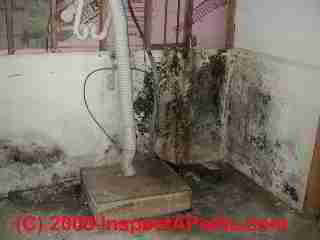 Mold or fungus growing on building surfaces -
Mold or fungus growing on building surfaces -
See MOLD in BUILDINGS for a guide to looking for mold contamination in or on buildings,
and see WHAT MOLD LOOKS LIKE for a guide to just what mold looks like on building surfaces.
Watch out: don't assume that all black stains are toxic dangerous mold, and don't assume that mold only shows up as "black" on building surfaces. There are harmful molds that are just about any color you can imagine, there are harmless black molds, and there are plenty of building stains that are not mold at all.
Be sure also to see MOLD APPEARANCE - STUFF THAT IS NOT MOLD to avoid becoming excited about harmless substances that people think are toxic mold.
If you know your building has a mold problem,
see ACTION GUIDE - WHAT TO DO ABOUT INDOOR MOLD.
Brown or other dark chimney stains on interior walls or ceilings near chimneys
See STAINS on/near CHIMNEYS where we discuss stains found on chimney exteriors or stains on building interior walls or ceilings near chimneys.
Also see SOOT STAINING - Black Soot Stains on Roof Shingles Around Chimneys
Also see more chimney related stains at PROXIMATE CAUSE of ROOF SHINGLE STAINS
Our home page or starting point for stain diagnosis is
at STAINS on & in BUILDINGS, CAUSES & CURES
And a catalog of indoor stains is
at STAINS on INDOOR SURFACES, PHOTO GUIDE
as well as STAINS & THERMAL TRACKING
See BLACK STAINS from ANIMALS for details about pet stains on building floors (urine) and walls (various) and see PET STAINS on WALLS for diagnosing stains such as the black marks left by pets on walls.
For outdoor stains,
see STAIN DIAGNOSIS on BUILDING EXTERIORS
We discuss carpet stains related to thermal tracking, air leaks, soot deposition in detail
at CARPET STAIN DIAGNOSIS and we discuss carpet and other indoor soot, dust & stain testing procedures at
Often these stains are mistaken for toxic indoor mold. When investigating a building for a mold problem, you can save mold test costs by learning how to recognize Stuff that is Not Mold or is only Harmless Mold but may be mistaken for more serious contamination - save your money.
Because some clients have on occasion sent samples to our mold test lab that really should not have been collected, much less looked-at, we provide this library of photographs of things that are "not mold" and don't need to be tested.
These are substances that you can easily learn to recognize in buildings. Save your mold test money, and increase the accuracy of your mold contamination inspection or test for toxic or allergenic mold in buildings: review these items to learn recognize non-fungal materials or even possibly harmless cosmetic "black mold" often mistaken for "toxic fungal growth."
Rule out natural color variations: Some apparent building stains may not be an actual stain at all but rather the original color or color variations in natural materials such as the birch plywood door shown at left. Sometimes what you think is a new building stain is actually a color variation that has been in place for some time, but was not previously attended.
Identify thermal tracking stains from normal house dust: If you are able to rule out specific air leaks causing normal deposition of house dust, and if you are quite sure that you have an abnormal level of stains/soot like material showing up on various surfaces then these courses of investigation are suggested as an aid to diagnosing stains on indoor ceilings, walls, floors, carpets, cabinet interiors, closet interiors, or even house contents:
How to Separate normal "thermal tracking" dust deposition patterns from other types of indoor staining
If stains or debris are appearing on surfaces which are not cooled by their location (such as exterior walls, hollow interior walls which are
entertaining internal air movement due to convection from below to above, areas near cooling air registers), then it may be possible to state
with confidence that the stains appearing are due more to a high level of particulate debris in the building than to the more common thermal
tracking phenomenon
See THERMAL TRACKING & THERMAL BRIDGING
How to Look for Causes of Indoor Stains
Look for the source or potential sources of abnormal levels of indoor airborne debris, soot, particles, dust, such as a malfunctioning oil or gas fired appliance, any other combustion sources, even a mal-adjusted pilot light on gas stoves or heaters can be a soot source as well as the oft cited candles, fireplaces, and even pets (for example lots of dog traffic between indoors and out brings in high levels of dust).
Photo at left: dark stains low on interior walls were identified as pet stains: a large dog frequently lay against the wall in the areas shown. [Click to enlarge any image]
See BLACK STAINS from ANIMAL for details about pet stains on building floors (urine) and for black or other pet stains on walls see PET STAINS on WALLS for diagnosing stains such as the black marks in our photo at left.
If/when we can identify an unusual source or a source producing an unusual level of particulate debris we have perhaps answered a key part of this question of the probable source of indoor soot, dust, or debris stains.
Measure Indoor Moisture Levels when Diagnosing Indoor Stains and Soot or Debris Deposits
OPINION: even in a relatively clean home, unusually high moisture levels may result in noticeable levels of dust deposition on indoor surfaces, regardless of the dust source, and even including normal types and sources of house dust.
If moisture levels are a factor in the home, say moisture regularly above 55% RH, we would expect to see more-stained surfaces on those building surfaces that are more likely to be a bit higher in moisture, such as cooler surfaces on walls, ceilings, or in closets or cabinets where temperatures are lower and moisture may condense at a slightly higher level.
Indoor Stain Diagnosis Using Air Movement Patterns
Sometimes we can identify particular sources of air movement, directions of air movement, which we can correlate with the areas where we see staining. A simple example is the higher amount of dust deposition that occurs around heating or air conditioning supply registers on ceilings and walls.
Relating air movement patterns to dust or soot or other debris stains may be diagnostic.
Also take a look at a short paper we wrote on an analysis of suspect indoor dust,
at HVAC DUST CONTAMINATION STUDY
where we determined that indoor dust levels which had been suspected of originating in an HVAC system were actually carpet dust and fibers.
How to Use Particle Identification to Diagnose the Source of Dust, Dirt, Soot, or Debris Stains
It is often possible to collect samples of suspect dust or debris for microscopic analysis in order to suggest a source or type of source of indoor stains.
It is essential that you select a forensic laboratory whose staff includes people experienced and trained in the identification of a wide range of indoor particles.
A lab specializing in mold or allergen identification, for example, may not consider much less apply methods used to identify oil burner soot, common components of ordinary house dust, mite fecals, pet dander, human skin ce
Stains Traced to the Building Water Supply
Stains on plumbing fixtures, laundry, appliances, and surfaces sometimes are traced to minerals or other contaminants in the water supply.
See WATER STAINING CONTAMINANTS
Reader Comments, Questions & Answers About The Article Above
Below you will find questions and answers previously posted on this page at its page bottom reader comment box.
Reader Q&A - also see RECOMMENDED ARTICLES & FAQs
On 2022-03-19 by Inspectapedia Com Moderator - Moisture stains, stringy fibers, white marks on flooring and unable to identify
@S.M.,
In some photos I see what looks like man-made fibrous material that could come from many different sources that one can't identify from your photos.
Some of your fiber photos suggest that the material is quite large - for example perhaps left by a mop or from furnishings - leaving one unable to assert that those alone are a hazard of any sort more serious than a normal "dust bunny" that accumulates in buildings.
(The principal components of house dust are fabric fibres and skin cells.)
In other of your photos I see what looks like a filler putty along with dirt and debris in what appear to be cracks or gaps between floorboards.
Other of your photos are too blurry to interpret.
I suggest a thorough HEPA vacuuming and cleaning of areas where you find annoying dust.
I'm sorry you feel you've already spent too much on other issues, and I wish our free advice could be more complete and diagnostic for you, but in this case, frankly the information you have provided is much too incomplete to imagine that one could diagnose a building environmental issue - or even confirm that there is one - from your photos and description to date.
In five decades of building forensic investigations and inspections I've found that in every case in which I or another experienced investigator went to a site to investigate a building indoor environment concern: dust, mold, or other unknowns, in one-hundred percent of the cases critically-important additional information that was never mentioned by the client or occupant was then found by the on-site investigator.
It's not that the client or occupant is dumb it's simply that a trained, experienced investigator will notice things that would not catch the eye of a normal building occupant.
On 2022-03-19 by S.M.
S.M. replied by private email 2022/03/19, re-posted by (mod)
I would love to hire an inspection but already have too much spent on mold and insect inspections.
I am sending more pics again hoping these may help in figuring this out or maybe tell me if my wood floors should look as they do in these pictures?
The most recent occurance are lots of white strings appearing all over and I will include these as well. Something very strange is happening and I just dont know what to do.
On 2022-03-02 by Inspectapedia Com Moderator
@S.M.,
A competent onsite inspection by an expert usually finds additional clues that would permit a more accurate, complete, and authoritative answer than we can give by email alone. You will find additional depth and detail in articles at our website.
That said, I have these comments:
There are some moisture stains at wall bottom and on some flooring in some of your photos.
That black stringy material isn't something I can identify from your photo - it looks like some sort of packing.
"Sinking fireplaces" if there is actual movement is a warning that chimney(s) could be unsafe - including chimneys venting your home heating or hot water equipment - have those included in your structural inspection and hire a certified chimney sweep to be sure that any flues that are in use are safe.
Most of the photos are too blurry to allow us to zoom in for a closer look, leaving matters a bit uncertain.
One would wish you could find an experienced home inspector or environmental inspector who would listen to your concerns, consider the home's history, inspect it thoroughly outside and in for evidence of history of leaks, mold, insects, other pests, etc. and report to you.
CONSULTANTS & EXPERTS DIRECTORIES
might help you find someone suitable. Be sure to discuss your concerns and to listen to what services will be delivered before hiring someone. Don't hire someone who is going to do no more than stop by to "test" for something or other.
On 2022-03-02 by S.M.
Re-posted by (mod) from private email:
I am hoping for some help in determining what is happening to our home.
We have had inspection for both insects and mold and were told we have neither.
However, after living here for more than 20 years and not having any of the issues we now have I really think we have a problem.
I lean towards mold because I have constant allergy symptoms and because there are always odd things on surfaces all over the house and it is a constant job keeping the house clean, more dust more debri. The walls and woodwork have an odd texture and is slimy in spots when washing. The floors uncover odd things when scrubbed that although sounds strange appear out of nowhere.
The fireplace hearths are turning black and sinking in and have some white stuff that can be seen in the cracks as do all the wood floors.
I really need some help as this has been going on for a long time and has become life consuming trying to keep up.
I can only hope that the pics I am including (out of the many) are the right ones that can help you to give any advice what to do to make this end.
These are taken of a new dresser and upstairs wood floors and woodwork.
Any help is immensly appreciated.
On 2022-01-23 by Inspectapedia Com Moderator
@Chims,
Your steps sound reasonable;
Watch also for roof leaks near the eaves that might leak down into the wall.
On 2022-01-23 by Chims
@Inspectapedia Com Moderator, Thanks for the reply. The house is 24 years old and it's been fine until now. We did have some hail damage last summer and they are coming this spring to replace the roof and siding.
Maybe at that point I will be able to check to see if something is amiss. Perhaps something got damaged with the outside flashing from the hail but it's not obvious looking at it from the outside. Although there is a hole in the vertical portion of vinyl frame on the window outside.
I put tape over in an attempt to keep any moisture out but they are going to fix this as well.
On 2022-01-23 by Inspectapedia Com Moderator
@Chims,
That looks very much like a leak stain. It's possible that the window installation for the flashing above the window is incorrect.
You should be aware that there may be more water damage in the wall around and below that point and that wedding a wall cavity side or drywall can invite mold, rot, or even insect attack. It's worth a bit further investigation both outside above the window and inside behind the drywall.
On 2022-01-22 by Chims
I have a brown stain on an inside gypsum wall above a window casing. Any idea what it could be?
On 2021-12-17 by Inspectapedia Com Moderator
@Marc Puts,
If I understand correctly and this is an interior surface of a concrete wall, then I would agree that oils on concrete forms can contribute to fungal growth or staining.
However if that had happened on your wall, you would expect the stains or fungal growth to be more uniformly distributed across the surface that was in fact in contact with the form.
If it's indeed localized near the control joints, as appears to be the case, then it's probably not due to the forms.
On 2021-12-17 by Marc Puts
Please look at te stain on inside wall concrete build with forms and cedar strips : would it be a complication of using diesel on the form or form oil? Thank you
On 2021-05-24 - by (mod) -
@Baz,Perhaps if you post some photos, one per comment, along with a description of the history of the stains and when you observed them, we may be able to make some suggestions.
On 2021-05-24 by Baz
I just moved into a new build 2 story home there are numerous areas where yellow stains coming through white painted walls ranging from whole walls or from ceiling to wall line please advise as I'm fed up with constant bull$%#t from construction company
On 2021-04-2 by (mod) - Brown & Black stains on interior concrete floor slab - 1919 house in Seattle WA
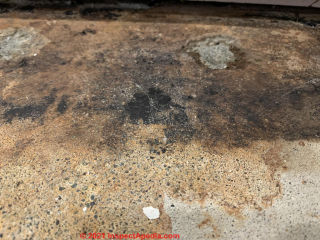 @Noah Davis, for the red stains try an iron stain remover.
@Noah Davis, for the red stains try an iron stain remover.
You'll also see dark stains like this on concrete after a fire, or where organics such as oils or saps or even asphalt from roofing felt used as housewrap have been wet and have leached out onto nearby surfaces.
Summarizing what we know or think so far:
If this floor could have had vehicles or machines containnig oil and grease, if the building ever had a fire, or if there were leaks (including from outdoors) from such contaminants onto the flor surface that may explain what we're seeing.
The fact that the concrete looks clean where the stained surface was chipped off or sanded off tells us that these stains came onto the surface from above, not from a contaminant seeping up through the slab.
The fact that the edges of the stain are lighter in color and in a pattern consistent with water leakage or a spill, getting darker closer to the wall edge, may indicate a prior leak at or spill at the wall.
Bleach won't remove asphalt nor heavy petroleum product stains nor burned-materials from a prior fire but other solvents might help
Recommendation:
In my opinion, the cost of grinding down the floor to restore a nice clean-looking concrete surface is not cost-justified for most residential properties with a badly-stained concrete floor.
If you want to try removing these stains, the concrete cleanign suggestions
at x can be useful. Take a particular look at
U.S. GSA POULTICING LUBRICATING AND PETROLEUM OIL STAINS FROM CONCRETE [PDF] retrieved 2020/12/14
Excerpt:
This procedure includes guidance on removing oil stains such as lubricating and petroleum oil from concrete using chemical solvents in poultices and bandages. Four different methods are described.
Alternatively, simply clean, dry and seal the floor. Take a look at the products listed at
ASBESTOS ENCAPSULANTS & SEALERS - Sealant Paints & Coatings for Asbestos, Asbestos Cement or Transite Surfaces -
Some of those are described as able to bond to and seal contaminated surfaces including asphalt mastic on concrete floors.
As long as there is no water or moisture problem in the slab, a coating can leave the floor looking clean and ready for any other covering you may then decide to put down.
On 2021-04-23 by Noah Davis - Brown & Black interior concrete floor slab in 1919 house in Seattle WA
Thanks for taking the time to look and respond. I'm posting a closeup as well. I think that your theory is probably right that at some point that window well leaked water down to the floor.
Not sure it matters, but it's not at all "bubbling" like those pictures. And it's rather smooth feeling actually. Some other thoughts/observations:
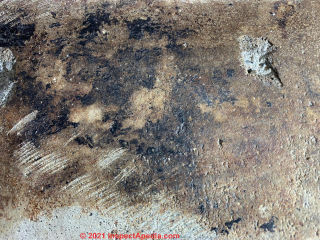
* It looks like from this picture that maybe someone try to scape or sand it off before?
* Is the black stuff possibly a kind of sealant that was used to patch cracks? It doesn't matter that much, as long as it's not mold!
* (Note the hole is unrelated, a nail was removed)
The house was built in 1919 in Seattle. I have since applied both bleach and a liquid TSP substitute to little effect. Some of the black stuff can be scraped off, but the brown stained color remains. A soot / sap does seem like a possibility.
On 2021-04-23 by (mod)
@Noah Davis, perhaps that window well is adding a water trap that sends water down the foundation wall and inside - worse if a roof edge drains into that area along the wall.
Aside from mineral deposits and efflorescence that can be recurrent EFFLORESCENCE & BROWN DEPOSITS https://inspectapedia.com/Wet_Basements/Brown_Red_Effloresence.php
often leaks through a wall will dissolve and re-deposit any of a number of surrounding materials in soil, in the structure itself.
But on a floor and looking again at your dark black-brown stains on concrete and noticing those round sander cuts (or something similar) in your second photo), to me this looks like an organic stain left behind from asphalt or from an oil or grease spill, even from a fire.
And in that location something could have leaked onto the floor from outside, particularly as a window-well invites basement water entry. A leaky oil tank, oil delivery, or similar spill can also produce dark brown and black stains.
Have you tried smelling the floor to see if there is an oil or heating oil odor? Or an asphalt or tar odor?
I'd try some of the concrete cleaner products, scrape, clean, dry, seal, and paint as has been painted the nearby floor.
See CONCRETE STAINS: ID & REMOVAL
On 2021-04-23 by Noah Davis
Thanks for the link, I did look but nothing quite matched.
This is inside, concrete on basement floor, shared with exterior wall. See picture. It used to be covered by a rug, but this room has had water intrusion so we had to rip out the rug.
On 2021-04-23 by (mod)
@Noah Davis,
CONCRETE STAINS: ID & REMOVAL
should be helpful to you.
From just the photo I don't have enough context to wager a guess about what's going on. I don't know if this is indoors, outdoors, siding at ground, garage slab, wall materials, etc.
If those stains are organic such as from oil or asphalt, bleach won't do a thing.
That glassy feel makes me wonder if there was ever a fire in this area.
On 2021-04-23 by Noah Davis
I tried to remove this stain (on concrete) with (diluted) bleach, but it’s stubborn. The brown surface actually has something of a glassy feel to it in parts. We have had water intrusion in this room in the basement. Any ideas?
On 2020-11-06 by (mod) - red streaks on the wall in my laundry closet.
Lavern
I'll be glad to try to help but I just can't know enough from your text to have a useful opinon; a red streak could be old paint bleed through, a leak stain, even a fungal yeast growing through paint.
If there is a history of leaks into the wall there's a chance of hidden mold.
You can post one image at a time - per comment; see if you can get a sharp photo of the wall from a bit of distance so I can see the context,
then try a sharp close-up image.
You can also search Inspectapedia.com
for WHAT MOLD LOOKS LIKE or
for PHOTOS of RED MOLD to make some comparisons.
On 2020-11-06 by Lavern
There are red streaks on the wall in my laundry closet. There appears to be a box at the top of the ceiling above the dryer. It is a rental property. The streaks were there when we moved in in March . The property manager had it painted in April. The streaks are back. The property manager asked if I smelled anything in the spring, but I had Covid and could not smell.
Since the red streaks came back I am not sure if I can smell anything. But does anyone here an idea of what it is. The streaks are confined to running down the wall beneath the box that seems like a pipe may be in it.
On 2020-07-10 by (mod) - nail pops and "peg pops" in concrete?
In a poured concrete wall we would not expect nails nor wooden pegs to "pop" out of the wall surface.
A more-likely guess is that someone drilled holes and tapped wooden pegs into the concrete to serve as a nail base for hanging something on the wall.
These "pops" do occur in drywall - those details are
On 2020-07-10 by Janice
Also, I saw pegs sticking out the wall now, they probably got pushed out by moisture, since they were not visible before and were under paint/ concrete. I don't know a whole lot on construction work.
Might this be from construction for pouring the concrete or could that be a professional mold cleaning procedure from a previous attempt of removing molds in this appartment? Or those are just pegs from holding something in the wall. (see photo, black spots are pegs with darker stain around them)
These stripes in the previous picture seem that liquid was dripping down, i think this damage was done by too much humidity without venting, but it might also come from outside?
I advised that the resident should contact the landlord, but she is afraid of the cost implications that this will produce, since most likely she will be held accountable at least to some degree because of insufficient venting.
On 2020-07-10 - by (mod) - diagnose & cure dark mottled, blotchy, or water run-down stains on interior concrete wall
I agree that the stains on your concrete walls may be an artifact from original forms work and construction. If so they're not harmful and are only a cosmetic issue.
You will see other examples of similar un-invited stains on concrete
at CONCRETE STAINS: ID & REMOVAL in the reader Q&A section near the bottom of that page where I will post and hope we can continue this discussion.
Some discolorations in concrete, including dark areas, are natural, not harmful, and are not economical, if even possible, to remove.
If the owner has cleaned the wall surface there's not likely to be mold on that surface.
When the wall is dry, not leaking, and stable, if you object to its colors and appearance it can be painted or stained with a product designed for use on concrete.
On 2020-07-10 by Janice
How would you go on to remove these stains or molds? [Photo above]
Is it possible to remove them without professional help in your opinion? The owner cleaned the area with H2O2 cleaner, but didn't remove the mold properly before. Is bleach and or TSP adivsible?
Thank you for your previous answer!
On 2019-12-18 - by (mod) -
Sounds like an unfortunate and painful lesson on the importance of inspecting a property thoroughly before you rent or buy.
On 2019-12-18 by Chad Verner
Stains in a rental I leased before inspecting. They were everywhere on the floor including under where furniture sat. It also had dead kissing bugs everywhere which transmit Chagas disease. I spent maybe 3 hours in the unit before I knew of the bug.
Thought it was boxelder and wasn't concerned. There was also dead bed bugs , roaches and fungus . I started to clean and then decided this rental was not for me.
Called landlord and she said I signed lease and kept money and says I broke lease by abandonedment. It was gross . I have 141 pics of nasty stuff.
On 2019-09-15 - by (mod) - dark stain on my cathedral ceiling
Lets start the diagnosis at THERMAL TRACKING BRIDGING GHOSTING
https://inspectapedia.com
On 2019-09-15 by kathryn pitts
I noticed a dark stain on my cathedral ceiling it is 1 to 1 and 1/2 inches wide and approximately 2 feet long 2 roofing companies told me there is nothing wrong with the roof and the stain is dry . frankly they both said they have no idea what it ishelp.
On 2018-10-16 - by (mod) - strange stain on the wall
Ali
Twas perhaps a dark and blurry night for stain photography but anyway I'm not sure what we're seeing. In the photo the wall surface looks raised, as if, perhaps, due to moisture. Is it flat or is it raised? Is there moisture or are there possibly leaks behind that wall?
On 2018-10-16 by Alistair
I have found a strange stain on the wall and cannot determine what has caused it. We have had rodent problems but I cant see how this is related.
The image shows the stain on the wall however I wiped away a load of dark coloured residue from the skirting board. This must be an animal surely but how is the stain so high up the wall!?
IMAGE LOST by older version of Clark Van Oyen’s useful Comments code - now fixed. Please re-post the image if you can. Sorry. Mod.
On 2017-01-07 - by (mod) - I have stains on my carpets
Rosalie:
You're right to look for air leaks, and also water leaks from above, from walls that might run under a floor, or for interior spills that were previously cleaned but that may have affected the carpet fibers.
Take a look under your manufactured home to be sure there are no water leaks, loss of belly insulation, air conditioner or heat duct damage, nor animal invasion.
Please find more help
On 2017-01-06 by Rosalie
I have stains on my carpets, not from anything spilled on them. The stains are mostly central and large, however, one large one has appeared close to an outside wall. I cleaned them and found they were not that dirty, however, after they dried the stains were back.
What can be done about this? I live in a modular home that is skirted.
...
Continue reading at CARPET STAIN DIAGNOSIS or select a topic from the closely-related articles below, or see the complete ARTICLE INDEX.
Or see these
Recommended Articles
- CARPET STAIN DIAGNOSIS
- CEILING STAIN DIAGNOSIS
- CONCRETE STAINS: ID & REMOVAL
- EFFLORESCENCE SALTS & WHITE DEPOSITS
- MOLD APPEARANCE - WHAT MOLD LOOKS LIKE
- MOLD APPEARANCE - STUFF THAT IS NOT MOLD
- STAINS on INDOOR SURFACES, PHOTO GUIDE
- STAIN & BIODETERIORATION AGENT CATALOG causes and types of damage that raise aesthetic and conservation issues on cultural artifacts, buildings, and art works.
- THERMAL TRACKING BRIDGING GHOSTING - home
Suggested citation for this web page
STAIN DIAGNOSIS on BUILDING INTERIORS at InspectApedia.com - online encyclopedia of building & environmental inspection, testing, diagnosis, repair, & problem prevention advice.
Or see this
INDEX to RELATED ARTICLES: ARTICLE INDEX to BUILDING STAINS
Or use the SEARCH BOX found below to Ask a Question or Search InspectApedia
Ask a Question or Search InspectApedia
Questions & answers or comments about diagnosing the causes of stains found on indoor surfaces.
Try the search box just below, or if you prefer, post a question or comment in the Comments box below and we will respond promptly.
Search the InspectApedia website
Note: appearance of your Comment below may be delayed: if your comment contains an image, photograph, web link, or text that looks to the software as if it might be a web link, your posting will appear after it has been approved by a moderator. Apologies for the delay.
Only one image can be added per comment but you can post as many comments, and therefore images, as you like.
You will not receive a notification when a response to your question has been posted.
Please bookmark this page to make it easy for you to check back for our response.
Our Comment Box is provided by Countable Web Productions countable.ca
Citations & References
In addition to any citations in the article above, a full list is available on request.
- Thanks to Alan Carson, Carson Dunlop, Associates, Toronto, for technical critique and content suggestions about indoor stain diagnosis.
- In addition to citations & references found in this article, see the research citations given at the end of the related articles found at our suggested
CONTINUE READING or RECOMMENDED ARTICLES.
- Carson, Dunlop & Associates Ltd., 120 Carlton Street Suite 407, Toronto ON M5A 4K2. Tel: (416) 964-9415 1-800-268-7070 Email: info@carsondunlop.com. Alan Carson is a past president of ASHI, the American Society of Home Inspectors.
Thanks to Alan Carson and Bob Dunlop, for permission for InspectAPedia to use text excerpts from The HOME REFERENCE BOOK - the Encyclopedia of Homes and to use illustrations from The ILLUSTRATED HOME .
Carson Dunlop Associates provides extensive home inspection education and report writing material. In gratitude we provide links to tsome Carson Dunlop Associates products and services.


